Memorabilia
Collection: Series III - VIII
| SERIES III. METALWARE
Series III (Box 1), containing metalware, is one of the smallest of
the memorabilia collection. Three of the more interesting pieces
in this grouping have an impressive provenance attributed to them, although
their definite histories have never been proven. A pewter plate (III.2)
with an unknown coat of arms at the center has been identified by the donor
as a part of the original Lafayette family pewter. Also, a pair of
silver spoons (III.3.a-b) supposedly holding the monogram of the Lafayette
family are located in this series as well. |
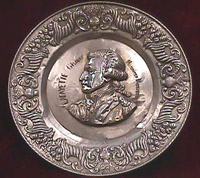 |
| SERIES IV. TEXTILES
The memorabilia of Series IV (Box 1-5) includes a diverse collection
of 19th-century textiles. Fabric pieces are arranged into five categories:
clothing, banners, drapery, doilies, and blankets. The most historically
valuable textile of this series is the embroidered waistcoat worn by Lafayette
at the time of his visit to the United States during 1824-25 (IV.1).
Other textile pieces dating from the 1824-25 tour have more indirect associations
with the Marquis de Lafayette, such as the banners carried in parades in
his honor (IV.3,4), fragments of a gown worn at a Lafayette ball (IV.2),
commemorative doilies labeling Lafayette as "The Nation's Guest" (IV.7,8),
and a woven blanket (IV.9) under which Lafayette was said to have slept
somewhere near York, Pennsylvania. Some of the more unusual textiles
in this series include fragments of drapery from the Paris room where Lafayette
died in 1834 (IV.5,6.a-b). |
 |
SERIES V. PERSONAL ACCESSORIES
Personal accessories of Series V (Box 1-8, oversize shelf D/3) include
objects purportedly owned by Lafayette as well as pieces manufactured in
his honor, primarily during the 1824-25 Farewell Tour. 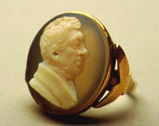 Series
V is organized into four major categories: jewelry, grooming devices, smoking
and snuff accessories, and miscellaneous.
Series
V is organized into four major categories: jewelry, grooming devices, smoking
and snuff accessories, and miscellaneous.
The jewelry of Series V includes rings, a locket, a watch, and pins.
All of these pieces date from the 19th century. In some instances,
the jewelry carries a portrait of Lafayette. Other pieces are associated
with Lafayette in several ways. A pocket watch (V.4) was presented
to a relative of the donor by Lafayette during his 1824-25 tour of America.
A ring (V.1) supposedly containing a lock of Lafayette's hair is located
here as well. 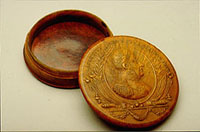
Grooming devices include a clothing brush with the bristles dyed to
spell "Lafayette - 1825" (V.7) and pocket mirrors holding a bust portrait
of Lafayette after Scheffer (V.8,9). 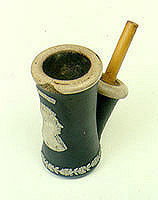 Smoking
and snuff accessories include a collection of 19th-century snuff boxes
in papier mache, ebony, and wood with portraits or scenes from Lafayette's
life displayed on the lids (V.11-15). A pipe in gray ceramic with
a portrait of Lafayette in relief on the bowl is located in this grouping
as well (V.10).
Smoking
and snuff accessories include a collection of 19th-century snuff boxes
in papier mache, ebony, and wood with portraits or scenes from Lafayette's
life displayed on the lids (V.11-15). A pipe in gray ceramic with
a portrait of Lafayette in relief on the bowl is located in this grouping
as well (V.10).
The miscellaneous category of Series V contains many personal accessories
in a variety of forms. Objects include hair combs (V.21), a buckle
(V.18), buttons (V.19-20), a scarf (V.21), gloves (V.22-24), fans (V.25-26),
a brief case (V.27), a cane (V.28), and umbrellas (V.29-30). While
some of these items were worn or carried at Lafayette-related events during
the 19th-century, most were manufactured specifically as commemorative
pieces for the 1824-25 tour of the United States.
SERIES VI. MEDALS AND RIBBONS
Series VI (Box 1-14) contains a fine collection of 18th and 19th-century
medals and ribbons. Over 140 medals and medallions are housed in
this collection (Box 1-13), and were struck in France and the United States. 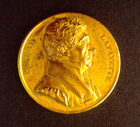 Every
medal in the collection is somehow related to Lafayette, with most medals
carrying a portrait of Lafayette in relief on the obverse side. In
some instances, the medals refer to specific historical events in which
Lafayette participated, but do not hold a Lafayette portrait. More
than 60 different medals are included as well as several copies and variations
of specific medals.
Every
medal in the collection is somehow related to Lafayette, with most medals
carrying a portrait of Lafayette in relief on the obverse side. In
some instances, the medals refer to specific historical events in which
Lafayette participated, but do not hold a Lafayette portrait. More
than 60 different medals are included as well as several copies and variations
of specific medals.
The earliest medal appears to have been issued in 1789, and the most
recent medals date from the present day. Approximately 30 medals
date prior to 1800 and were issued in commemoration of Lafayette's participation
in the French Revolution. Approximately 50 medals date after 1800
and up to 1834. These medals refer to Lafayette's 1824-25 tour of America,
his last political involvements in France ca. 1830, and his death in 1834.  Another
fifty-plus medals date from the latter part of the 19th century onward.
For the most part, these medals commemorate the anniversaries of Lafayette's
birth and death as well as events he was associated with throughout his
lifetime. The medals are arranged chronologically and are assigned
individual numbers which reflect their date, type, and the number of copies
in the collection (i.e., 1789.1.a). The first number indicates the
year the medal was first struck, the second number refers to the type of
medal, and the letters which follow indicate if the medal exists in copy
within the collection.
Another
fifty-plus medals date from the latter part of the 19th century onward.
For the most part, these medals commemorate the anniversaries of Lafayette's
birth and death as well as events he was associated with throughout his
lifetime. The medals are arranged chronologically and are assigned
individual numbers which reflect their date, type, and the number of copies
in the collection (i.e., 1789.1.a). The first number indicates the
year the medal was first struck, the second number refers to the type of
medal, and the letters which follow indicate if the medal exists in copy
within the collection.
The ribbons of Series VI (Box 14) represent approximately 25 varieties
of commemorative and mourning badges relating to the Marquis de Lafayette.
These ribbons, commonly pinned upon clothing in the 19th century, are usually
engravings on silk and display a portrait of Lafayette with printed text.
Most of the ribbons in this collection date from 1824-25 and were worn
during parades honoring Lafayette's final visit to America. Another
large group of the ribbons date from 1834 and mark the death of Lafayette.
Ribbons are arranged chronologically within this series.
SERIES VII. ICONOGRAPHY
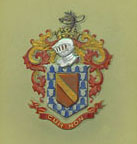 |
Series VII (Box 1-2) contains Lafayette iconography in the form of
art works framed and as statuettes. The framed pieces range from
a portrait of Lafayette on a ceramic tile (VII.1) to a painted family crest
of Lafayette (VII.2). Most framed pieces display a representation
of Lafayette in portrait. The statuettes include three painted porcelain
pieces showing Lafayette in the military dress of the Paris National Guard
(VII.7-8,11). Two statuettes are in bronze, one in full-figure entitled
"Lafayette at Yorktown" (VII.9) and one bust portrait cast in London in
1831 (VII.10). |
| SERIES VIII. WEAPONS
The weapons of Series VIII (Box 1) include four swords and one firearm.
Two of the swords were personal arms of Lafayette. The first, a three-edged
rapier (VIII.1), was surrendered by Lafayette after his capture in Austria
in 1792. The second, a presentation sword with case (VIII.2), was
a gift to Lafayette as Commanding General of the Paris National Guard from
his fellow officers. The 18th-century musket (VIII.5) located with
this series has been suggested to be one of the Charleville firearms brought
by Lafayette to the Americans in 1777. |
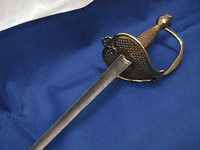 |
Back to Series I - II
| Next to Series IX - XIII






